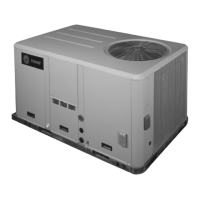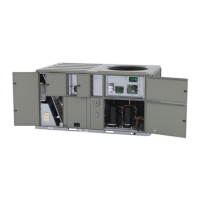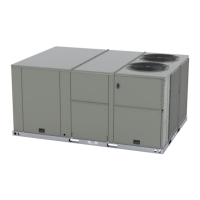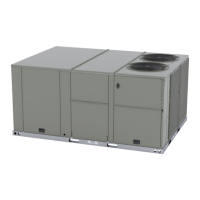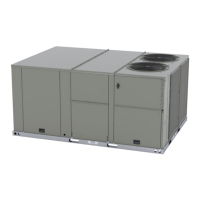30 RT-SVX39B-EN
Start-Up
Verifying Proper Air Flow
Units with Belt Drive Indoor Fan
Much of the systems performance and reliability is closely
associated with, and dependent upon having the proper
airflow supplied both to the space that is being
conditioned and across the evaporator coil.
The indoor fan speed is changed by opening or closing the
adjustable motor sheave.
Before starting the SERVICE TEST, set the minimum
position setpoint for the economizer to 0 percent using the
setpoint potentiometer located on the Economizer Control
(ECA), if applicable.
ReliaTel Control
Using the Service Test Guide in Tab le 6 , p. 3 0, momentarily
jump across the Test 1 & Test 2 terminals on LTB1 one time
to start the Minimum Ventilation Test.
Once the supply fan has started, check for proper rotation.
The direction of rotation is indicated by an arrow on the fan
housing.
With the fan operating properly, determine the total
system airflow (CFM) by;
1. Measuring the actual RPM,
2. Measure the amperage at the supply fan contactor and
compare it with the full load amp (FLA) rating stamped
on the motor nameplate.
a. Calculate the theoretical BHP using (Actual Motor
Amps/Motor Nameplate Amps) X Motor HP.
b. Using the fan performance table in the unit Service
Fact, plot the actual RPM (Step 1) and the BHP (Step
b) to obtain the operating CFM.
3. If the required CFM is too low, (external static pressure
is high causing motor HP output to be below table
value),
a. Relieve supply and/or return duct static.
b. Change indoor fan speed and repeat steps 1 and 2.
• To increase fan RPM; loosen the pulley adjustment set
screw and turn sheave clockwise.
• To decrease fan RPM; loosen the pulley adjustment set
screw and turn sheave counterclockwise.
• If the required CFM is too high, (external static
pressure is low causing motor HP output to be above
table value), change indoor fan speed and repeat steps
1 and 2.
• To stop the SERVICE TEST, turn the main power
disconnect switch to the “Off” position or proceed to
the next component start-up procedure.
Table 6. Service test guide for component operation
Test Step Mode Fan Econ
(a)
Comp1 Comp 2 Heat 1 Heat 2 Ohms
1FanOn
Minimum Position
Setpoint 0%
Off Off Off Off 2.2K
Minimum Ventilation On Selectable Off Off Off Off
2
Economizer Test
Open
On Open Off Off Off Off 3.3K
3 Cool Stage 1 On Minimum Position On
(b)
Off Off Off 4.7K
4
(c)
Cool Stage 2 On Minimum Position On
(b)
On Off Off 6.8K
5
(c)
Reheat On Minimum On On Off Off 33K
6
(c)
Heat Stage 1 On Minimum Off Off On Off 10K
7
(c)
Heat Stage 2 On Minimum Off Off On On 15K
(a) The exhaust fan will turn on anytime the economizer damper position is equal to or greater than the exhaust fan setpoint.
(b) The condenser fans will operate any time a compressor is “On“providing the outdoor air temperatures are within the operating values.
(c) Steps for optional accessories and non-applicable modes in unit will be skipped.
WARNING
Live Electrical Components!
During installation, testing, servicing and
troubleshooting of this product, it may be necessary to
work with live electrical components. Have a qualified
licensed electrician or other individual who has been
properly trained in handling live electrical components
perform these tasks. Failure to follow all electrical
safety precautions when exposed to live electrical
components could result in death or serious injury.

